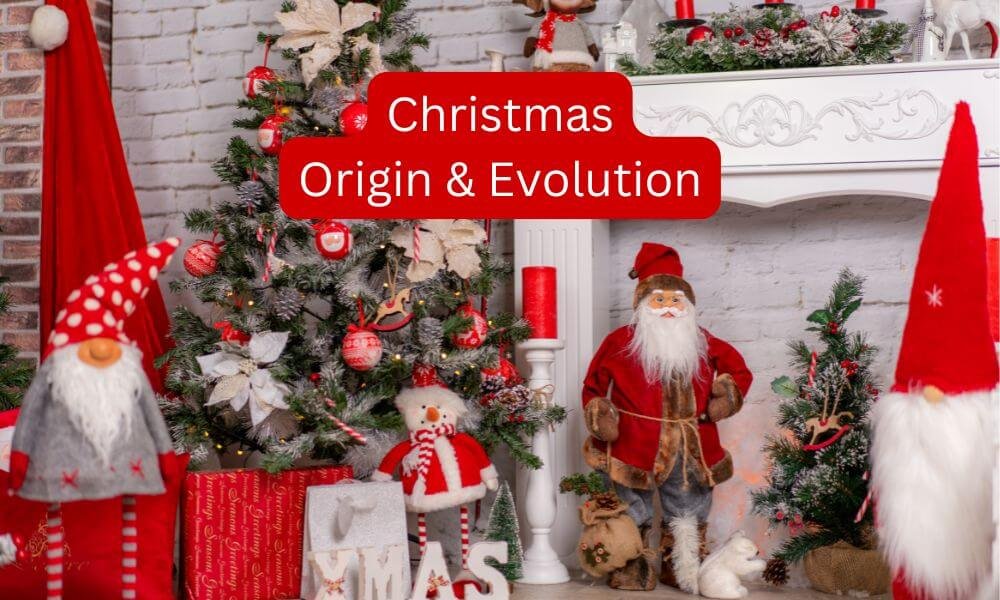The Origin and Evolution of Christmas
Christmas, celebrated on December 25th, is one of the most widely observed holidays worldwide.
Though it is a Christian celebration marking the birth of Jesus Christ, the holiday has roots that reach deep into pre-Christian traditions, pagan customs, and historical adaptations.
Over the centuries, Christmas has transformed, incorporating elements from diverse cultures and societies to become the global event we recognize today.
Pre-Christian Roots
The origins of Christmas can be traced back to various winter solstice celebrations held by different cultures long before the birth of Christ.
These celebrations often took place around the time of the winter solstice, the shortest day and longest night of the year, marking the rebirth of the sun and the promise of longer days ahead.
- Roman Festival of Saturnalia: One of the most notable influences on Christmas is the Roman festival of Saturnalia, a week-long celebration starting on December 17th.
Saturnalia was held in honor of Saturn, the god of agriculture, and was a time of feasting, merrymaking, gift-giving, and the reversal of social roles where slaves were treated as masters.
The revelry and spirit of generosity during Saturnalia strongly influenced later Christmas customs.
- Yule: In northern Europe, the Germanic people celebrated Yule, a festival honoring the return of the sun during the winter solstice.
Yule traditions included feasts, toasts to the gods and ancestors, and the burning of the Yule log, a custom that has endured in some form in modern Christmas celebrations.
The Birth of Christmas as a Christian Holiday
The early Christian church did not originally celebrate the birth of Jesus Christ. In fact, for the first three centuries, the focus was more on Christ’s death and resurrection.
However, as Christianity spread throughout the Roman Empire, church leaders sought to integrate local customs and festivals into Christian practices, a strategy known as “Christianization.”
- Choosing December 25: In the 4th century AD (325 CE at the Council of Nicaea), the Roman Emperor Constantine declared Christianity the official religion of the empire.
Around this time, December 25th was chosen to celebrate the birth of Jesus, likely to align with existing pagan festivals like Saturnalia (in honor of Saturn, the god of agriculture) and Sol Invictus (the Birthday of the Unconquered Sun).
This date had symbolic resonance, marking the rebirth of light after the darkest day of the year, which dovetailed with the Christian narrative of Jesus as the “Light of the World.”
- Early Christmas Celebrations: By the Middle Ages, Christmas had become a popular Christian holiday across Europe.
However, the focus was often more on feasting, revelry, and social customs than on religious observance.
This blending of sacred and secular traditions would continue for centuries, with local customs influencing the way Christmas was celebrated in different regions.
Medieval and Renaissance Christmas
During the Middle Ages (or Dark Ages in European history – approximately from 450 to 1450 CE), Christmas celebrations were often lively and exuberant, featuring feasts, games, and entertainment.
Many of these customs were inherited from older pagan traditions and were embraced by the broader Christian community.
- Feasting and Revelry: Much like Saturnalia, Christmas in medieval Europe was a time for indulgence, particularly for the wealthy.
Feasts were grand affairs, often featuring roasted meats like boar and goose, as well as sweets and alcoholic beverages.
Lords and nobles would host lavish feasts for their tenants and serfs, emphasizing the spirit of generosity.
- Mummers and Pageants: Mumming, a form of folk theater, was a popular part of medieval Christmas celebrations.
Mummers would dress in costumes and perform plays, often involving themes of good versus evil, and the triumph of light over darkness—paralleling the religious significance of Christmas.
- The Reformation and Christmas: The Protestant Reformation in the 16th century, led by figures like Martin Luther, brought significant changes to Christmas traditions.
Some Protestant groups, particularly the Puritans, viewed Christmas as overly indulgent and pagan in nature. In fact, during the 17th century, Christmas celebrations were banned in Puritan-controlled areas of England and New England.
However, despite these bans, the festive nature of Christmas eventually persisted, especially in more moderate Protestant and Catholic areas.
The Victorian Transformation of Christmas
The 19th century, especially during the reign of Queen Victoria (on throne from 1837 to 1901) in England, is often credited with shaping the modern Christmas we know today.
The Victorian era saw a shift toward family-centered, domesticated celebrations, as well as the introduction of many now-familiar traditions.
- Charles Dickens’ “A Christmas Carol”: Published in 1843, Charles Dickens’ novella played a pivotal role in redefining Christmas as a time of compassion, generosity, and goodwill.
The story of Ebenezer Scrooge’s transformation from miser to benefactor reinforced the idea of Christmas as a time for charity and helping those in need.
Dickens’ portrayal of Christmas, with its emphasis on family gatherings, festive meals, and the “Christmas spirit,” resonated with readers and influenced holiday customs.
- Christmas Trees and Decorations: The Christmas tree, originally a German tradition, became popular in England during the 19th century, particularly after Prince Albert, Queen Victoria’s German husband, introduced the custom at Windsor Castle.
Decorating the tree with candles, ornaments, and later electric lights became a beloved holiday activity.
The Christmas tree soon spread to the United States and other parts of the world.
- Gift-Giving: While gift-giving had always been a part of Christmas celebrations, the Victorian era saw a shift toward a more family-oriented exchange of presents.
Gifts were increasingly given to children, reinforcing the idea of Christmas as a family holiday centered around domesticity and generosity.
The Globalization of Christmas in the 20th Century
The 20th century saw Christmas become a global cultural phenomenon, thanks in part to mass media, consumerism, and the commercialization of the holiday.
- Santa Claus and Commercialization: The figure of Santa Claus, derived from the Dutch Sinterklaas and the historical Saint Nicholas, became an iconic symbol of Christmas during the 20th century.
In the United States, advertising campaigns by companies like Coca-Cola helped solidify the image of Santa as a jolly, rotund figure dressed in red, delivering gifts to children around the world.
This image of Santa became nearly universal, influencing Christmas celebrations globally.
- Consumerism and the Christmas Economy: Christmas became increasingly commercialized during the 20th century, with retailers seizing on the holiday season as a key shopping period.
The concept of Christmas Shopping became widespread, and the holiday became synonymous with gift-giving on a large scale.
The commercialization of Christmas has drawn criticism from some, who argue that it detracts from the holiday’s religious and cultural significance.
Nonetheless, for many, shopping and gift-giving remain central to the Christmas experience.
- Christmas in Popular Culture: Hollywood films, television specials, and music further popularized Christmas traditions and themes.
Classic films like “It’s a Wonderful Life” (1946) and “Miracle on 34th Street” (1947), along with Christmas songs like “White Christmas” and “Jingle Bells,” helped create a shared cultural lexicon for the holiday.
Contemporary Trends in Christmas Celebrations
In the 21st century, Christmas continues to evolve, shaped by globalization, technological advancements, and changing cultural attitudes. While many traditional customs remain, new trends and challenges are emerging.
- Global Adaptations of Christmas: As Christmas has spread to non-Christian countries, it has often been adapted to fit local customs and cultures.
In Japan, for example, Christmas is celebrated as a secular holiday, with traditions like eating KFC on Christmas Eve and exchanging romantic gifts.
In many countries, the religious aspect of Christmas is downplayed in favor of the festive and commercial elements.
- Eco-friendly and Minimalist Christmas: In recent years, there has been a growing awareness of the environmental impact of Christmas celebrations, particularly regarding waste from excessive gift packaging, decorations, and food consumption.
Some families are embracing more sustainable practices, such as giving experiences instead of material gifts, using eco-friendly wrapping paper, or choosing reusable decorations.
The rise of minimalism has also influenced how some people approach Christmas, with a focus on simplicity and reducing the excesses associated with the holiday.
- Technology and Virtual Celebrations: Advances in technology have transformed how people celebrate Christmas. Social media platforms, video calls, and online shopping have become integral parts of the holiday experience for many.
Families separated by distance can now connect virtually, while online shopping has made gift-buying more convenient than ever before.
- Inclusivity and Diverse Celebrations: In multicultural societies, there is an increasing emphasis on making Christmas inclusive for people of all faiths and backgrounds.
Some cities and communities celebrate Christmas alongside other winter holidays, such as Hanukkah and Kwanzaa, emphasizing common themes of peace, goodwill, and togetherness.
Conclusion
Christmas has a rich and complex history that spans millennia, drawing from both pagan and Christian traditions.
What began as a religious observance has evolved into a global celebration marked by a mix of religious, cultural, and commercial elements.
As Christmas continues to adapt to modern times, it remains a holiday that brings people together in a spirit of joy, generosity, and reflection, transcending its origins to become a truly universal festival.


